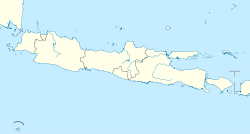Sewu
Appearance
| Sewu Temple Compound (Manjusrigrha) | |
|---|---|
 The Sewu temple compound | |
| General information | |
| Architectural style | Buddhist candi |
| Town or city | Klaten Regency, Central Java |
| Country | Indonesia |
| Coordinates | 7°44′37″S 110°29′37″E / 7.7435°S 110.4935°E |
| Completed | circa 8th century |
| Client | Sailendra or Mataram Kingdom |

Sewu (Indonesian: Candi Sèwu) is a Buddhist temple built in 8th century. It is 800 metres north of Candi Prambanan. Candi Sewu is the second largest Buddhist temple complex after Borobudur temple. Candi Sewu complex consists of 249 temples, although it is called 'Candi Sewu' which means 'a thousand temples' (in Javanese language). This candi is very much related to famous local folklore of Loro Jonggrang.[1][2]
Gallery
[change | change source]-
Candi Sewu Layout.
-
Main temple and apit temple of Candi Sewu.
-
Bodhisattva relief on wall of the temple.
Related pages
[change | change source]References
[change | change source]- ↑ Gunawan Kartapranata; Septa Inigopatria; Emille Junior (2015-04-20), "Candi Sewu Mandala Suci Manjusrigrha", Harian Kompas via Youtube, retrieved 2022-03-08
- ↑ Joachim Schliesinger (2016). Origin of Man in Southeast Asia 5: Part 2; Hindu Temples in the Malay Peninsula and Archipelago. Booksmango. p. 7. ISBN 9781633237308.





